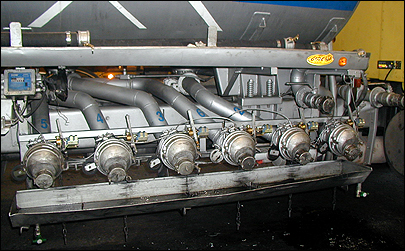Paz Energy, an Israeli energy company, is using active RFID to track when the fuel valves and hatches on its tanker trucks are opened and closed as drivers deliver fuel to filling stations around the country.
Paz owns gas stations and convenience stores, and it also has its own distribution company, which supplies the stores with fuel from its own refinery. In late 2004, the company began working with Hi-G-Tek to design a system that would help Paz secure the valves on tanker trucks (as required by Israeli law), as well as deter fuel thefts and improve the efficiency of the fuel-delivery process.
Consequently, Hi-G-Tek—formerly based in Israel but now operating a worldwide sales and marketing network out of Rockville, Md.—designed the Tanker Truck Monitoring System (TTMS), which utilizes active RFID tags built into tanker valves and hatches. Each time a valve or hatch is opened or closed, its RFID tag transmits a signal that is picked up by an interrogator mounted in the cab of the truck. The interrogator then relays the data, via a general packet radio service (GPRS) connection, to a computer in a central command center in Tel Aviv, where managers oversee tanker trucks and their deliveries. TTMS works in conjunction with a GPS-enabled fleet management system from Starcom Systems, a Hi-G-Tek partner, so Paz can also track its trucks’ locations.
Paz began implementing the vehicle-tracking and fuel-monitoring solution on its trucks in 2005, taking the application operational by the end of 2006. By May of this year, most of the 50 trucks in the Paz fleet, and many belonging to third parties that deliver fuel for Paz, were equipped with the hardware. A total of 100 trucks are expected to be outfitted by year’s end.
Before Paz implemented TTMS, drivers used mechanical clip seals on the valves and hatches. They had to keep track of seal numbers, writing them down by hand. Later, the company began using electronic reusable seals provided by Hi-G-Tek, and it has now moved to the RFID-enabled seals.
The fact that GPS tracks the exact location of each vehicle and RFID records any opening and closing of fuel hatches and valves provides Paz a strong theft deterrent. “The main problem was that we wanted to assure that our trucks arrive at our gas stations filled up, and that nobody opened the compartment along the way,” says Moshe Sabag, Paz’s vice president of IT. “We took the system to be sure that the compartments are opened just in the locations where we want it. With the system, we get real-time reporting and real-time information.”
Now, when a driver arrives at a station and begins pumping fuel from one of the truck’s 12 valves or hatches, managers at the command center can oversee which types of fuels are being pumped, and for how long, enabling them to calculate the amount of fuel delivered to a station.
“The 12 RFID seals tell managers what’s happening with the truck,” says Larry Blue, president and CEO of Hi-G-Tek. “The control center knows if the driver has opened the right valve at the right station, and if he’s delivering the right grade of fuel.”
The system also helps Paz keep more accurate inventory counts, because it provides a better understanding of how fuel is used by its customers. With more accurate inventory levels, Paz is less likely to run out of fuel during delivery runs.
The RFID-enabled seals were custom-designed by Hi-G-Tek’s development team, based in Israel. The seals have a battery life of about five years and read ranges of up to 300 feet. They operate on a proprietary air-interface protocol developed by Hi-G-Tek, designed to help preserve battery life. For the majority of time, the seals remain in listening mode, which uses minimal battery power, but are awakened when the interrogator sends a signal to retrieve the data from the seals. “The way you design the air interface has a significant impact on battery life,” says Blue. The protocol is based on two full-duplex radio channels; one operates at 125 kHz, he says, the other at one of the lower ISM band between 300 and 916 MHz.
According to Blue, the seals are the only wireless seals available that are certified as intrinsically safe—that is, that the electronics in the seals are guaranteed not to emit any sparks or static electricity that could set off a fire. The certification comes from the Underwriters Laboratories, an independent, not-for-profit product safety certification organization that tests products and writes safety standards. The seals also comply with the European Union’s ATEX regulations, Blue says.
Neither Hi-G-Tek nor Paz will reveal how much was invested in the system, though Blue says the companies have signed service agreements. Hi-G-Tek paid for the hardware, while Paz paid for the installation, and Hi-G-Tek receives a monthly service fee for operating and maintaining the system. Hi-G-Tek also customized Paz’s SAP enterprise resource planning (ERP) system to work with the new data collected by the RFID system.
During the implementation of the project, Hi-G-Tek had to grapple with what Blue calls standard software bugs, as well as hardware design. For example, the design of the RFID tags had to be modified because of how the valves and hatches are used, and due to the extreme summer heat in Israel. The tags also had to withstand some heavy-duty, but typical, abuse. “If a driver kicks a hatch shut,” Blue notes, “that’s a pretty big shock.” Hi-G-Tek provided training for drivers, the installation team and workers in the control center.
Hi-G-Tek has sold similar applications in Mexico and three other Latin American countries, as well as in one Eastern European country.



